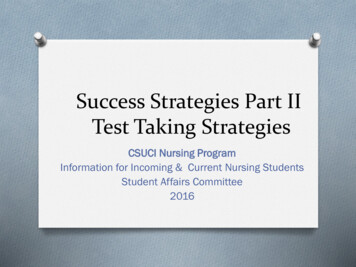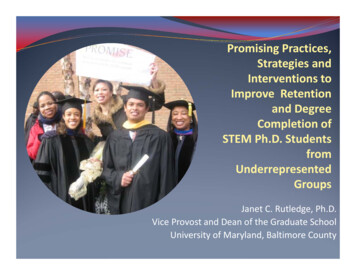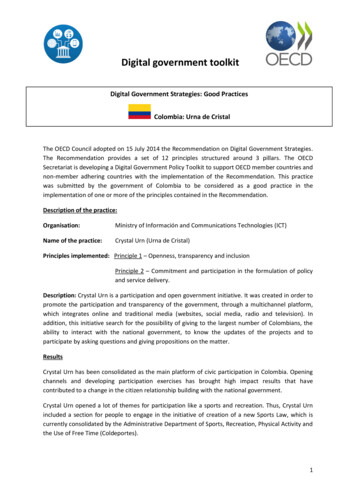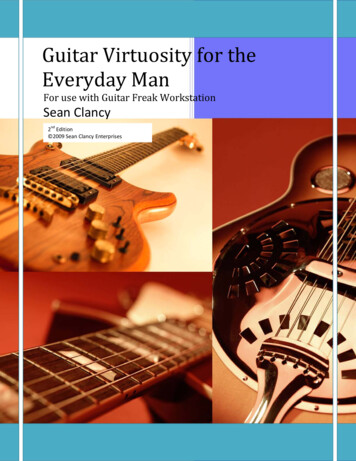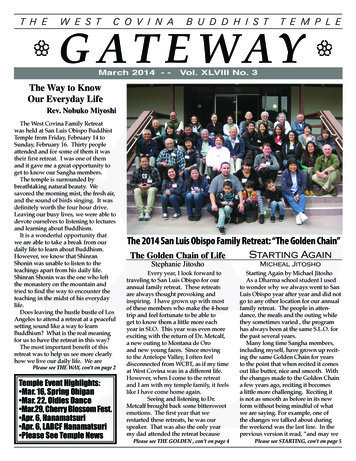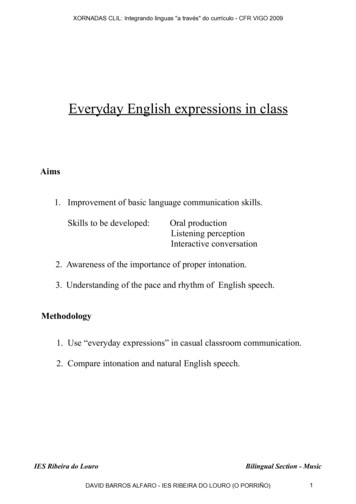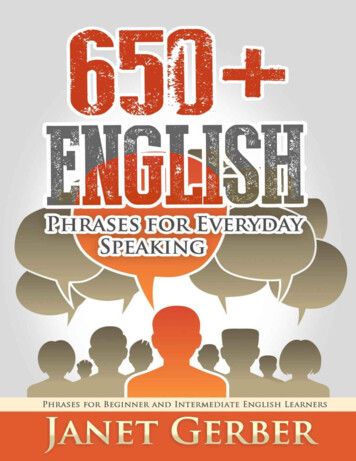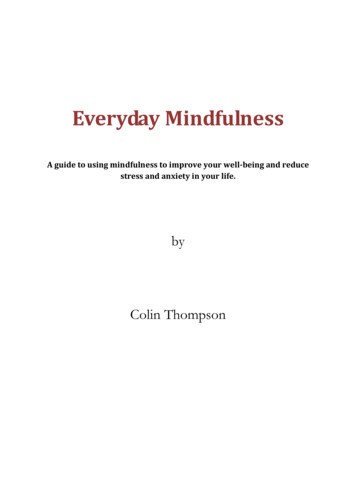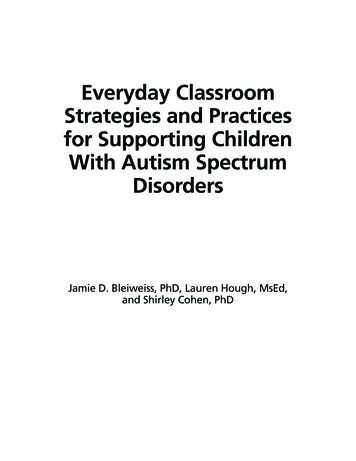
Transcription
Everyday ClassroomStrategies and Practicesfor Supporting ChildrenWith Autism SpectrumDisordersJamie D. Bleiweiss, PhD, Lauren Hough, MsEd,and Shirley Cohen, PhD
2013 AAPC PublishingP.O. Box 23173Shawnee Mission, Kansas 66283-0173www.aapcpublishing.netAll rights reserved. Except for the forms downloadable for the owner of this book, no partof the material protected by this copyright notice may be reproduced or used in any form orby any means, electronic or mechanical, including photocopying, recording, or by any information storage and retrieval system, without the prior written permission of the copyrightowner.Publisher’s Cataloging-in-PublicationBleiweiss, Jamie D.Everyday classroom strategies and practices for supporting children with autismspectrum disorders / Jamie D. Bleiweiss, Lauren Hough, and Shirley Cohen. -- ShawneeMission, Kan. : AAPC Publishing, c2013.p. ; cm.ISBN: 978-1-937473-81-5LCCN: 2013940030A manual on classroom practices to supplement “The ASD nest model” (AAPCPublishing, c2013).Includes bibliographical references.Summary: Evidence-based classroom practices for supporting students withautism spectrum disorders in the general education classroom. Companion volumeto “The ASD nest model: a framework for inclusive education for higher functioningchildren with autism spectrum disorders.”--Publisher.1. Autistic children--Education--Handbooks, manuals, etc. 2. Autism spectrumdisorders--Patients--Education--Handbooks, manuals, etc. 3. Teachers of children withdisabilities--Handbooks, manuals, etc. I. Hough, Lauren. II. Cohen, Shirley, 1937- III.Title. IV. Title: ASD nest model.LC4717.5 .B54 2013371.94--dc23This book is designed in Frutiger.Cover design by Rex Huang.Printed in the United States of America.1306
DedicationTo the staff of ASD Nest programs at schoolsthroughout the five boroughs of New York Citywho use the strategies and supports in this manual every day,and especially to Dorothy Siegel, whose intensive driveturned the idea of an inclusion program for children with autismspectrum disorders into the reality of the ASD Nest program.And finally, to the children and families who provided uswith evidence of the goodness-of-fitof the strategies and supports we used every day.iii
AcknowledgmentsWe wish to thank the central staff of consultants to the ASD Nest program for their myriadcontributions to the practices presented in this manual, in particular Angela Mouzakitis, SusanBrennan, Kristie Koenig, Gizem Tanol, and Aaron Lanou. We are also grateful to Brenda SmithMyles and Kirsten McBride at AAPC Publishing for their support throughout the process ofproducing this manual.The ASD Nest program reflects a long collaborative process involving two university colleges –New York University’s Steinhardt School of Culture, Education and Human Development, andHunter College of the City University of New York – and the New York City Department of Education. We wish to thank the administrators of all three institutions who supported and contributed to this relationship so that the ASD Nest program could be established and continue its workwith children on the autism spectrum.v
Table of ContentsPreface. ixChapter 1: Introduction. 1The ASD Nest Program Classroom Guideposts . 3The Three-Tier Model of Supports for the ASD Nest Program . 4Case Examples . 8Conclusion . 8Chapter 2: Classroom Guideposts . 9Overview of the ASD Nest Program.10Prevention Strategies .12Instructional Strategies and Supports .26Social Supports That Strengthen Social Relational Development and Social Cognition.35Replacement Behavior .42Positive Reinforcement Systems .48Using the Classroom Guideposts .53Conclusion .54Chapter 3: Three-Tier Model of Supports.55Using the Tier I Classroom Checklist of Strategies and Supports .56Using the Tier I Checklist of Strategies and Supports for Individual Students.64Using the Tier II Checklist of Strategies and Supports for Individual Students.70Using the Tier III Checklist of Strategies and Supports for Individual Students.77Conclusion .93Chapter 4: The Three-Tier System and the Classroom Guideposts in Action .95The Tier I Classroom Checklist in Operation.95The Tier I Checklist of Strategies and Supports for Individual Students .106The Tier II Checklist of Strategies and Supports for Individual Students .114The Tier III Checklist of Strategies and Supports for Individual Students .129References .158About the Authors .163vii
PrefaceShirley CohenEveryday Classroom Strategies and Practices for Supporting Children With Autism Spectrum Disorders was conceptualized in the spring of 2012 after the manuscript of the bookThe ASD Nest Model: A Framework for Inclusive Education for Higher-Functioning Children With Autism Spectrum Disorders was completed and submitted to AAPC Publishing. Thatbook provides the structure or “bones” of the ASD Nest program along with the story of howit was created, a sampling of the content of the program, and a general picture of how it wasdoing. A description of the students served by the ASD Nest, the professional developmentprogram that undergirds the ASD Nest, the challenges in sustaining an inclusion program forchildren with ASD within a large urban school system, and the voices of parents of childrenserved by this program are also included in that book. The book gives district and school administrators, supervisors, advocates, and parents a template for what an effective inclusionprogram serving higher-functioning children with autism spectrum disorders (ASD) might looklike, how it could be established, and how it might operate.While that book delineates an overall approach and samples of strategies for the classroom,we realize that many teachers would benefit from more than that – from a stronger focuson everyday classroom practices designed to meet the needs of children with ASD. That realization led to the production of this manual on classroom practices. The manual can be usedas a companion to the book for everyone involved in the education and treatment of children with ASD, and for classroom teachers and their support teams, it can also stand alone.Chapter 1 is a brief overview for readers who are not familiar with the ASD Nest programthat was presented in The ASD Nest Model.ix
Chapter 1IntroductionShirley CohenOne can barely read the news these days without encountering some mention of autism,usually communicating alarm about its increased prevalence or the myriad possible factors, genetic and environmental, that may cause or trigger it. Parents-to-be and parentsof infants are frightened. Well-known figures from the entertainment field are lending themselves to fundraising efforts for research into this condition. Conferences on autism abound. Arguments about diagnosis and labeling pervade the medical and educational fields. Should theterm “autism spectrum disorder” have replaced the terms “autistic disorder, Asperger’s disorder,and pervasive developmental disorder-not otherwise specified (PDD-NOS) in the latest versionof the widely used diagnostic manual of the American Psychiatric Association (DSM-5)? Whatgenes cause autism? And finally, what treatments and/or supports that are available now willhelp which children the most?It is this last question that this manual and the book associated with it, The ASD Nest Model(Cohen & Hough, 2013), address. The co-founders (Dorothy Siegel and Shirley Cohen), consultants, and long-term staff of the ASD Nest program have developed and have been implementing an intervention model for higher-functioning children with autism spectrum disorders (ASD) that has enabled almost all of the children in this program to be successfully educated in classes with their more typically developing peers in neighborhood public schools.While providing support for the special needs of these children, we are strengthening theirability to understand and meet social and academic expectations.Who are these “higher functioning” children with ASD?1
Everyday Classroom Strategies and Practices for Supporting Children With Autism Spectrum DisordersThey are children who have challenges in social communication and interactions along with restricted and repetitive patterns of behavior, interests, and activities. Many are highly routinedependent and resistant to change. Some have unusual reactions to sensory stimuli, with hypersensitivity to one or more types of sensory input. Some have poor self-regulation and frequentmeltdowns. Others need extra time to process verbal communications and respond to them.Many are highly anxious. Some flap their hands or jump up and down when they are anxious orexcited. And many are passionately interested in selected subjects and are intellectually curiousas well as creative. Virtually all have IQs within the range considered average or higher, and allhave received a diagnosis of autism, either prior to being considered for admission to the ASDNest program or during the admission process. Most children are admitted at kindergarten age,with a few being admitted in higher grades when there are openings in the program.The strategies and classroom practices described in this manual were designed for the ASDNest program. The ASD Nest model is an inclusion program serving children who have ASD,particularly higher-functioning children with that condition. As of the 2012-2013 school year,the ASD Nest program was being implemented in 19 public elementary schools in New YorkCity. While the program serves children on the autism spectrum who are often referred to ashigh-functioning or “higher-functioning,” many of the practices in this book will be useful inworking with children with ASD who are not usually thought of as higher functioning, as wellas other populations of children with special needs, including children identified as having attention deficit hyperactivity disorder (ADHD) and children with learning or behavior disorders.The principles behind these practices take into consideration each child’s needs, strengths, andinterests, all basic to sound and effective instruction in both general and special education.The ASD Nest model includes the structural elements listed below. (For more extensive information about this model, see The ASD Nest Model [Cohen & Hough, 2013]). Many, if not most, ofthe discrete strategies recommended in this manual can also be utilized in programs that do notinclude all the structural elements of the ASD Nest model, provided that an overall framework ofpositive behavior support exists. Reduced class size: 12 students at the kindergarten level, 4 of them children with ASD; 16students in grades 1-3, 4 of them with ASD; up to 20 students in grades 4-5, up to 5 of themwith ASD Co-teaching: two classroom teachers, one certified in special education and one in generalearly childhood or childhood education, or teachers certified in both special education andgeneral early childhood or childhood education; plus a cluster teacher, who divides her timebetween ASD Nest classes to support children during special subjects and instructional lunch A transdisciplinary team approach with weekly team meetings that include teachers, related service providers (speech-language pathologist, occupational therapist, social worker),and a school administrator (principal or assistant principal)2
Chapter 1: Introduction A central team of ASD consultants – positive behavior support specialists, speech-languagepathologists, and special educators with a focus on ASD, who work with participatingschools during their first two years in the program and on an “as-needed” basis after that.(In some schools that have been in the program for more than two years, the consultant isreplaced by a “coach/cluster teacher;” that is, an experienced ASD Nest teacher who has received additional training and is provided with several periods for coaching each week.) Targeted goal areas: social understanding and social communication, self-regulation andcoping skills, adaptive behavior, selected academic skills needed by individual students in order to meet grade expectations Use of intervention strategies delineated in the Classroom Guideposts for the ASD Nest program and the Three-Tier Model of Supports for the ASD Nest program, which are presentedlater in this manual. (In addition, there is a social development intervention focus, SDI, led byeach program’s speech-language pathologist, consisting of sessions that take place outside theclassroom daily at the kindergarten level and three times a week at higher grade levels.) Preservice training consisting of two graduate courses focused on ASD taken at Hunter College in the summer prior to beginning work in the ASD Nest program Inservice training during the school year through workshops and conferences led by theconsultants to the ASD Nest Support Project at New York University Home-school connection: home and school visits for new students before the start of theschool year; two-way communication notebooks; school-based parent meetings; workshopsand conferencesPermeating all elements of the ASD Nest program is an overall framework of positive behavior support and a welcoming, supportive atmosphere.The ASD Nest Program Classroom GuidepostsThe Classroom Guideposts document is a compendium of strategies and practices that arebasic to the ASD Nest model and are used frequently in all classes in the program. Many ofthe strategies have a strong evidence base in relation to students with ASD while others areconsidered highly promising, and still others are accepted as best practice in special education. These practices focus on the needs and challenges common to children with ASD (Smith,Myles, Aspy, Grossman, & Henry, 2010; Stansberry-Brusnahan & Collet-Klingenberg, 2010).However, the way Guidepost practices are implemented varies depending on age/grade differences between classrooms. Use of these strategies and practices is guided by team planningfor both individual students and whole classes.The Classroom Guideposts are organized into five categories that have guided our thinking aboutintervention: prevention strategies, instructional strategies and supports, social supports, teach-3
Everyday Classroom Strategies and Practices for Supporting Children With Autism Spectrum Disordersing replacement behavior, and positive reinforcement systems. However, these categories are notmutually exclusive, as some practices can be and are used for multiple purposes.The Classroom Guideposts are introduced to new staff of the ASD Nest program during theirsummer training program prior to beginning work in the program, and they are also used as a resource in planning for classes and for individual students throughout the school year. The Guideposts are expanded periodically as new strategies and practices are identified that are consistentwith the overall approach of the model and have been found to be beneficial to students in theprogram. The latest version of the Classroom Guideposts is presented in Chapter 2.Three-Tier Model of Supports for the ASD NestProgramThe Three-Tier Intervention Model, the ASD Nest version of a response-to-intervention (RTI)system (Fuchs, Fuchs, & Compton, 2012; Van DerHeyden & Burns, 2010), provides guidelinesfor which strategies and practices from the Classroom Guideposts to use with which studentsand when. The three tiers are defined by frequency and intensity of service delivery and by thelevel of direct adult involvement. Each tier is organized into four domains: behavioral, social,academic, and sensory functioning/self-regulation supports.The ASD Nest Three-Tier Model differs from the broader use of RTI in that all tiers in the ASDNest system are designed for use with special education students, particularly students withASD. Thus, Tier I is designed to be used with all students in inclusion classes – both children onthe autism spectrum and their more typically developing peers. Tier II is used for students withASD (or other special needs) for whom the practices at Tier I are insufficient to help them meetindividualized education program (IEP) goals or program expectations. This tier consists ofindividualized strategies and supports that are implemented in small groups, sometimes withinitial teaching in a one-to-one format. Finally, Tier III is designed for students who have majordifficulty in meeting expectations even after Tier II strategies have been used for some time.The intensive, highly individualized supports in Tier III are only used after careful assessmentby the school team and an ASD Nest program consultant, as well as a meeting with a child’sparent. Practices in Tier III are substantially more intensive than those of Tiers I and II, and theyrequire much one-to-one teaching, support, and monitoring. As a result, they may reduce theamount of teacher support that can be given to other students, and are therefore generallyused only when a student is at risk of being considered for movement to a more restrictivesetting. Figure 1.1 presents the conceptual model of the ASD Nest Three-Tier system. The fullmodel is presented in Chapter 3.4
Chapter 1: IntroductionTIER IIITier III supports require significant, intensive individual interventions, and ongoing consultation with ASD Nest consultants.Intensive, individual interventions (consultation required)TIER IIIn order to move to Tier II, it must be determined at a team meeting that all appropriate Tier I strategies were tried and found to beinsufficient to address student needs.Individualized, planned strategies, added to Tier I interventionsTIER ITier I strategies are core features of all Nest classrooms and are appropriate
Nest program. The ASD Nest model is an inclusion program serving children who have ASD, particularly higher-functioning children with that condition. As of the 2012-2013 school year, the ASD Nest program was being implemented in 19 public elementary schools in New York City. While the program


